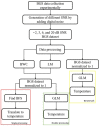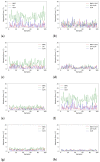Improving Prediction Accuracy and Extraction Precision of Frequency Shift from Low-SNR Brillouin Gain Spectra in Distributed Structural Health Monitoring
- PMID: 35408291
- PMCID: PMC9003443
- DOI: 10.3390/s22072677
Improving Prediction Accuracy and Extraction Precision of Frequency Shift from Low-SNR Brillouin Gain Spectra in Distributed Structural Health Monitoring
Abstract
In this paper, we studied the possibility of increasing the Brillouin frequency shift (BFS) detection accuracy in distributed fibre-optic sensors by the separate and joint use of different algorithms for finding the spectral maximum: Lorentzian curve fitting (LCF, including the Levenberg-Marquardt (LM) method), the backward correlation technique (BWC) and a machine learning algorithm, the generalized linear model (GLM). The study was carried out on real spectra subjected to the subsequent addition of extreme digital noise. The precision and accuracy of the LM and BWC methods were studied by varying the signal-to-noise ratios (SNRs) and by incorporating the GLM method into the processing steps. It was found that the use of methods in sequence gives a gain in the accuracy of determining the sensor temperature from tenths to several degrees Celsius (or MHz in BFS scale), which is manifested for signal-to-noise ratios within 0 to 20 dB. We have found out that the double processing (BWC + GLM) is more effective for positive SNR values (in dB): it gives a gain in BFS measurement precision near 0.4 °C (428 kHz or 9.3 με); for BWC + GLM, the difference of precisions between single and double processing for SNRs below 2.6 dB is about 1.5 °C (1.6 MHz or 35 με). In this case, double processing is more effective for all SNRs. The described technique's potential application in structural health monitoring (SHM) of concrete objects and different areas in metrology and sensing were also discussed.
Keywords: BFS extraction; BOTDA; Brillouin scattering; concrete; data processing; distributed fibre-optic sensors; machine learning; structural health monitoring.
Conflict of interest statement
The authors declare no conflict of interest.
Figures









Similar articles
-
Machine Learning Approaches in Brillouin Distributed Fiber Optic Sensors.Sensors (Basel). 2023 Jul 6;23(13):6187. doi: 10.3390/s23136187. Sensors (Basel). 2023. PMID: 37448034 Free PMC article. Review.
-
Wavelet convolutional neural network for robust and fast temperature measurements in Brillouin optical time domain reflectometry.Opt Express. 2022 Apr 25;30(9):13942-13958. doi: 10.1364/OE.451877. Opt Express. 2022. PMID: 35473148
-
Performance analysis of frequency shift estimation techniques in Brillouin distributed fiber sensors.Opt Express. 2018 May 28;26(11):14661-14677. doi: 10.1364/OE.26.014661. Opt Express. 2018. PMID: 29877403
-
Brillouin Frequency Shift of Fiber Distributed Sensors Extracted from Noisy Signals by Quadratic Fitting.Sensors (Basel). 2018 Jan 31;18(2):409. doi: 10.3390/s18020409. Sensors (Basel). 2018. PMID: 29385052 Free PMC article.
-
Review: distributed time-domain sensors based on Brillouin scattering and FWM enhanced SBS for temperature, strain and acoustic wave detection.Photonix. 2021;2(1):14. doi: 10.1186/s43074-021-00038-w. Epub 2021 Jul 30. Photonix. 2021. PMID: 34841256 Free PMC article. Review.
Cited by
-
Machine Learning Approaches in Brillouin Distributed Fiber Optic Sensors.Sensors (Basel). 2023 Jul 6;23(13):6187. doi: 10.3390/s23136187. Sensors (Basel). 2023. PMID: 37448034 Free PMC article. Review.
References
-
- Duque-Redondo E., Masoero E., Manzano H. Nanoscale shear cohesion between cement hydrates: The role of water diffusivity under structural and electrostatic confinement. Cem. Concr. Res. 2022;154:106716. doi: 10.1016/j.cemconres.2022.106716. - DOI
MeSH terms
Grants and funding
LinkOut - more resources
Full Text Sources
Medical
Research Materials
Miscellaneous

